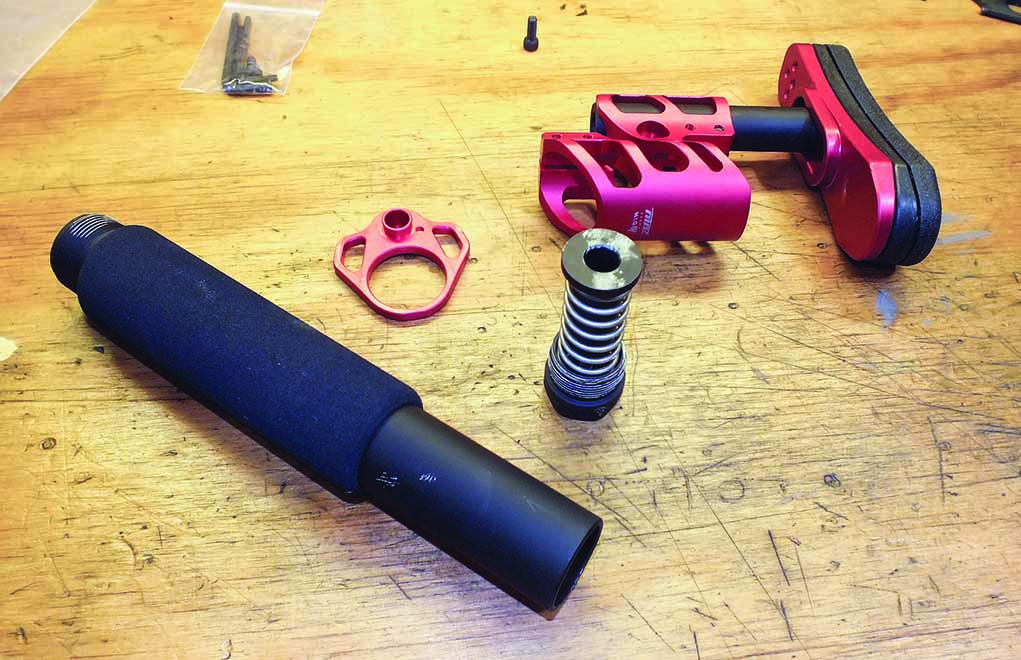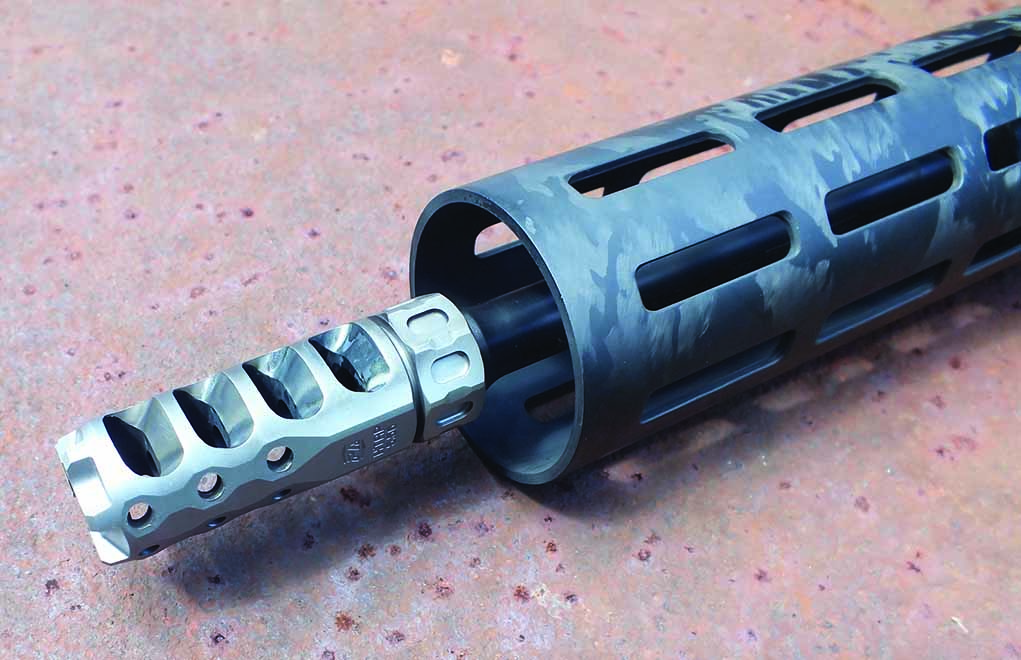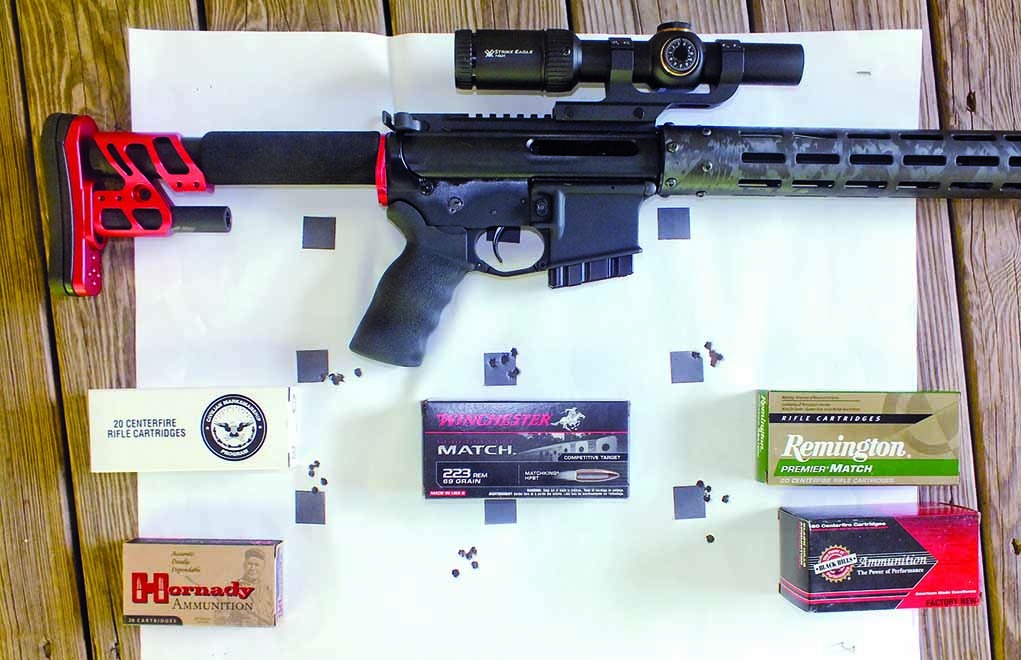
The precision AR-15 build is designed to keep double-taps within an inch at 10 yards — while maintaining 1-MOA accuracy at 100 yards.
What to consider in a precision AR-15 build:
It was one of those across-the-lunch-table conversations that occur often with guys who like guns. My friend and shooting companion of more than 30 years, Mike Byrd, and I were eating chips and salsa at a local Mexican restaurant and thinking about AR-15 carbines. He’d built a lightweight gun and was surprised that a light AR, which tipped the scales at just past 5 pounds, had repeatedly shot sub-MOA groups.

Light guns work really well for the fast-paced Carbine Bay matches so popular in North Carolina where ranges past 200 yards are fairly uncommon. We began thinking of how to build a light carbine that would shoot sub-MOA and also be tuned to be stable enough for double-taps that placed both bullets within 1 inch at 10 yards. By double-tap, I mean two shots with one sight picture, fired as fast as the trigger can be pulled.
In general, AR-15s in 5.56 NATO don’t have recoil, but they do have movement. Because of the reciprocating mass of the bolt and bolt carrier, standard ARs bounce about 4 inches at 10 yards in the 2 o’clock direction for right-handed shooters. That bounce can put the shooter out of the A zone on a target or slow down the shooter’s time because he must get the gun back on target for the second shot.
Learn More: .223 vs 5.56: The Ultimate Comparison & Review
For several years I’ve owned a great rifle that will accomplish the task. I tested, and later purchased, a CR 18 Colt Competition Rifle — and it’s been a great gun. I’ve shot two and three gun matches, I won a local NRA High-Power match and shot a mid-master score in the NRA National Championship with it. It’s been a great rifle, but it’s a bit slow and front heavy for those fast-paced Bay Matches.

The object of this project gun was not only to shoot accurately and without bounce, but the gun also had to be fast moving with the weight concentrated toward the rear, making for faster transitions. The goal weight was 6 pounds. And before my Speedy Gonzales lunch arrived, we were working out the details. By the time the tacos, enchiladas and refried beans were gone, we had a plan.
Receiver
You can spend a lot of money on upper and lower receivers, but the primary function of both is to hold the parts together. Since this project was also to build the best gun for an affordable price, we chose an economical Anderson Manufacturing lower receiver. For an upper, we chose the DPMS Low Profile Competition receiver without forward assist or a dust cover. It’s simple and smooth, has nothing superfluous, and is probably stiffer than a standard receiver. Upper and lower receivers were about $130 combined.
Barrel
Obviously, choosing the right barrel is important in a gun that’s to be judged on accuracy. Based on Mike’s past experience with them, I chose the Faxon Mid Length Match Series barrel in 16-inch Gunner. It’s a lightweight barrel with a Wylde chamber and a 1:8 twist, which will handle a wide range of bullet weights, and the mid-length gas system is proven to work with proper tuning for stability during fire. Faxon’s reputation for accurate lightweight barrels sealed the deal. MSRP is $225.
Read More: Getting the AR Barrel and Receiver Configuration Correct
Stock

The first interface between shooter and gun is the stock. I like adjustable stocks, but I don’t like wobble. I chose the Odin Gunworks Zulu 2.0 Adjustable Stock Kit. The Zulu Adjustable is a complete kit that replaces the buffer tube, buffer and stock. The buffer tube is covered with dense foam for comfort. The buffer is spring loaded to smooth out recoil (one of the objects of the project) and the stock is wildly adjustable. It adjusts in every direction I’d want adjustment except cheek placement. It’s also very reasonably priced with an MSRP of $149.
Pistol Grip
Related to the stock is the hand grip. Fast-moving guns must be held in a vise-like grip, and I’ve always been a fan of the Ergo Tactical Deluxe Grip. It’s got a tacky surface and a palm swell that fills my hand. I like the largest, but Ergo has an AR grip to fit any hand. Functional and affordable, it’s a great value at $39.
Bolt Carrier
A crucial part of a stable firing AR is the bolt carrier. After all, almost all the reciprocating weight that causes bounce comes from the bolt carrier. We chose the Rubber City Titanium carrier with their patented adjustable gas key. Titanium carriers lose weight because titanium has the highest strength-to-density ratio of any metallic element, with the bonus of being highly corrosion resistant. This carrier fills the space of an M16 profile while reducing weight substantially. There is a downside, however, because titanium is softer than steel — but RCA’s sister company, H&M Metal Processing, recently developed a new patented thermal chemical diffusion process to treat titanium and titanium alloys for high-wear applications. Another feature of the RCA carrier is the adjustable gas key that replaces an adjustable gas block. I admit I was skeptical, but the proof is in the shooting. MSRP with the adjustable gas key is $409.
More Info: A Word on AR-15 Carrier Life
Trigger

There are so many triggers for ARs on the market that I knew making a decision was going to be tough. Mike and I discussed a lot of options, but since this was a test bed kind of project, I wanted to keep an open mind. Before we’d made a final decision, I got an email about Mossberg’s new Jerry Miculek Adjustable Match trigger. I took the email as a sign from above. It’s a drop-in trigger, factory-set at a pull weight of 4 pounds, and it offers a crisp, creep-free break and user-adjustable overtravel. MSRP is $161.
Learn More: How-To: Trick Out Your AR Trigger
Handguard
Lightweight, especially at the front of the gun, was an important part of this project, and Mike has been using Isler Custom Gun Works ICGW handguards on the SIG MPX PCC carbines he’s been building. He felt they were the best. They’re made from Aerospace-quality, filament-wound carbon-fiber with CNC machined M-Lok ports. Weight of the 15-inch tube is just 6.8 ounces. The handguard mount is made from 7075 aluminum and attaches to the handguard with Torx button-head screws. The system comes with shims for perfect alignment and a unique barrel nut wrench. MSRP is $299.95.
Find Out More: Installing A Free-Floated Handguard On Your AR-15
Muzzle Brake

Besides controlling reciprocating mass, the most important part of tuning an AR-15 for stability is the muzzle brake. I’ve heard more positive feedback about the Precision Armament brake than any other, and we chose their newest model, the Hypertap 556. It solves one of the most difficult issues in tuning muzzle brakes by adding a lock nut to the system. To get the desired angle for maximum stability, the tuner can rotate and lock the brake in place without using shims. There are also 12 dimples in the brake to allow fine-tuning the amount and direction of side jetting. To gain more side jetting, the tuner drills out the indentions until the desired effect is gained. On the project gun, we drilled out three holes at 2 o’clock to bring the gun to stability. MSRP is $179.95.
Find Out More: Choosing A Flash Suppressor, Muzzle Brake And Compensator
Buffer Spring
There were other components, but the only other notable one was the use of a Tubb flat buffer spring. Music wire and carbon steel springs are adversely affected by temperatures. Stainless-steel springs retain their values better and are less affected by temperature.
More Info: Should You Replace Your AR-15 Buffer and Springs?
Optic
While the project gun is designed for accuracy, the primary issue is speed because it’s designed for time/score matches. Speed requires lightweight and fast target acquisition, and reflex sights excel in this area. I chose the C-More Railway red-dot with the 2-MOA dot because it affords the ability to exploit pinpoint accuracy, and the brightness level exceeds many other reflex sights. Mike was an integral part of this project and he likes the Railway because it’s so forgiving of head position, which is crucial in events where awkward positions are part of the game. It’s very reasonably priced with an MSRP of $279.
Read More: What Are Your Options For AR Optics?
Taking It To Task
Of course, the proof is in the shooting. The goal: 1-inch double-taps at 10 yards, 1-MOA at 100 yards, weight at 6 pounds and light in the muzzle.
Weight
Our first test occurred before the carbine fired a single shot. On precise scales, we missed our target mark of 6 pounds by a bit more than 2 ounces. A lighter stock would’ve filled the bill, but I like the Odin stock much more than anything lighter. The extra weight is close to the shooter and has little effect on fast transitions.
Double-Tap Testing

The next test was stability during fire. We began testing by firing single shots with an unloaded magazine to regulate the gas through the RCA adjustable gas key. We made three adjustments until the bolt failed to lock back. At that point, we were only a half turn from bottomed out. We backed out a quarter turn, achieved bolt lock and installed the locking set screw.
The next part of the tuning was to adjust the muzzle brake. Mike guessed at the first setting, and it was pretty good with a bit of push to the right. We drilled one hole at a time at 2 o’clock until we felt the gun was neutral. Now we were ready for the double-tap test.
Our first double-tap resulted in two shots almost touching — and subsequent double-taps were well within the requirement of the project and some touched. Redirecting gas at that velocity creates sound, and there’s plenty. Though sound was powerful, the rifle was as stable as a .22 rimfire AR-15. It’s almost eerie. Requirement accomplished: Everything we shot was well within the one inch at ten-yard standard.
Accuracy Testing
Real accuracy testing happens with a minimum of five-shot groups. In the real world, not many 6-pound semi-auto rifles are capable of sub-MOA accuracy. To test, I chose five loads: Remington, Winchester, Federal, Black Hills and Hornady. Results are in the included photo. Three of the five loads achieved better than 1 MOA on the first group fired. The worst group in the test was just over 1.5 MOA — all with less than 100 rounds through a new barrel.
The Package

To wrap it up, the project “AR Frankenstein” turned out very well. With the C-More sight installed, the gun finished out at a svelte 6 pounds, 12 ounces. It shoots sub-MOA with readily available factory ammunition and has the recoil of a .22 rimfire. Total cost of the project, including the sight, was $1,927.
This wasn’t a project to build a gun and save money — the object was to build a purpose-built carbine for a specific goal. I doubt there’s any commercial carbine that would achieve what’s been achieved at this level of expense, and it’s a one-of-a-kind carbine that achieves the goal.
Our Top Articles on AR-15 Builds and Performance
- Affordable AR-15 Rifles – A Buyer's Guide
- AR-10 vs AR-15 – How Stoner’s Rifles Stack Up
- Upgrade Your AR-15 with the Best Parts & Accessories
- AR-15 Lower Building Tips – Putting The Internals Together
- How it Works: AR-15 Upper Assembly
- Buyer's Guide: Top AR Pistol Braces
- AR Pistol Reviews – Best Options for Any Budget
- AR-15 Caliber Guide – What Should You Chamber Your Carbine?
Editor's Note: This article originally appeared in the November 2018 issue of Gun Digest the Magazine.

Next Step: Get your FREE Printable Target Pack
Enhance your shooting precision with our 62 MOA Targets, perfect for rifles and handguns. Crafted in collaboration with Storm Tactical for accuracy and versatility.
Subscribe to the Gun Digest email newsletter and get your downloadable target pack sent straight to your inbox. Stay updated with the latest firearms info in the industry.

![Best Concealed Carry Guns In 2025 [Field Tested] Wilson Combat EDC X9S 1](https://gundigest.com/wp-content/uploads/Wilson-Combat-EDC-X9S-1-324x160.jpg)


![Best 9mm Carbine: Affordable PCCs [Tested] Ruger Carbine Shooting](https://gundigest.com/wp-content/uploads/Ruger-Carbine-Shooting-100x70.jpg)
![Best AR-15: Top Options Available Today [Field Tested] Harrington and Richardson PSA XM177E2 feature](https://gundigest.com/wp-content/uploads/Harrington-and-Richardson-PSA-XM177E2-feature-100x70.jpg)

Customized AR-15 sounds a great idea but must be hard to build especially for beginners. I started gaining more interests in guns, especially on rifles so hope I can build a personalized one someday.